Aspirin is used to reduce fever and relieve mild to moderate pain consitions such as muscle aches, toothaches, common cold, and headaches. It may also be used to reduce pain and swelling in conditions such as arthritis. Aspirin known as a Salicylate and a Nonsteroidal anti-inflammatory drug (NSAID)
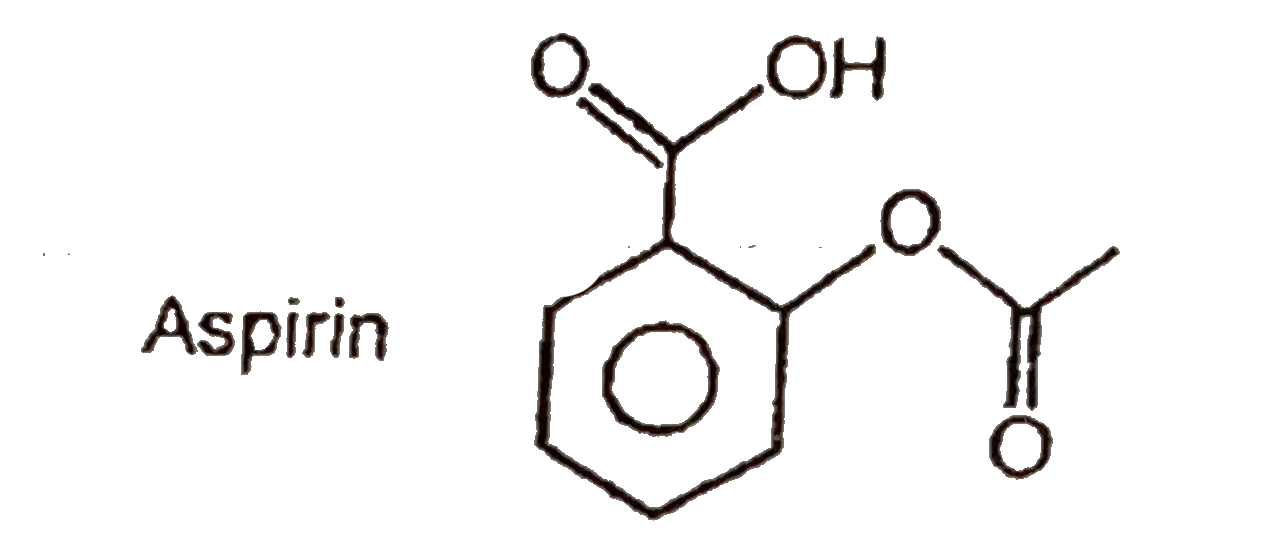
Which of following is true about Aspirin.
Carboxylic acid is principal functional group as a suffix in IUPAC name of aspirin.
Double bond equivalence of aspirin = 6
Total 3 primary (1∘) hydrogen is present in aspirin.
Functional group present in aspirin are carboxylic acid and ether.
The correct Answer is:A, B, C
(A) Priority of COOH is higher than ester.
(B) double bond equivalence = 1 ring +5π bond.
(C ) 
Topper's Solved these Questions
Similar Questions
The chemicals used to treat diseases and to reduce the suffering from pain are known as drugs or medicines. The chemicals used in chemotherapy are classified according to their action.
For example antipyretics are medicines used to lower the body temperature in high fever. The examples of antipyretics are para ethoxy acetamide and analgin.
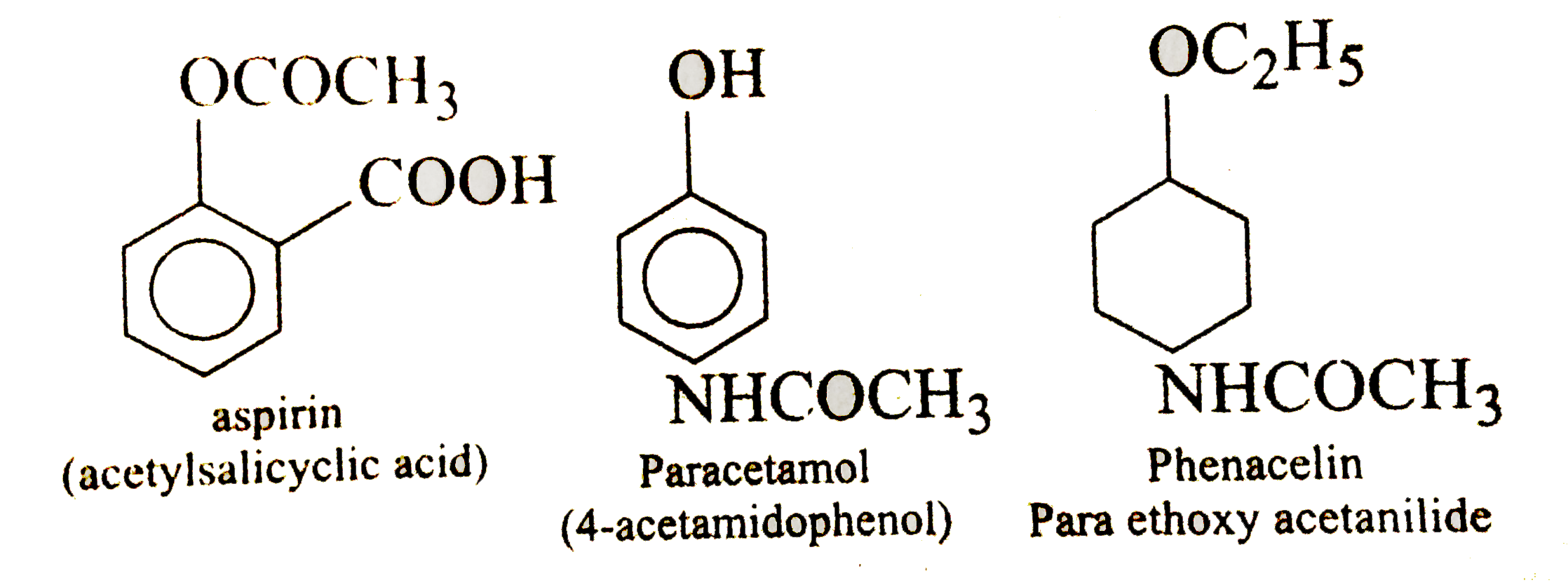
Analgesics are medicines which relieve pain. They are of two types. (i) Narcotics are medicines which relieve pain by producing sleep and unconsciousness. They are morphine, morphine diacetate (heroin) and codeine. They are habit forming (ii) None narcotic analgesics are not habit forming and do not usually induce sleep. They are aspirin, brufen and butazolidine.
Antiseptics are medicines which kill or prevent the growth of micro-organisms. Antiseptics are also used to reduce odours arising out of bacterial decomposition on the surface of the body. They are 2% solution of phenol, dettol (a solution of terpineol and chloro-xylenol) savlon, bithional etc.
Tranquillizers are medicine used to relieve mental tension and an anxiety. They act on the nervous system and induce sleep. They may antidepressants (to elevate mood) such as methedrine and vitalin, sedatives (relieve mental agitation and violence) such as diazopam, seconal, luminal and equanil.
Antibiotics are medicines produced by micro-organisms such as fungi, bacteria and moulds and are used to kill other microorganisms. They are penicillin (Treat sore throat, bronchitis, pneumonia), streptomycin (active aginst tuberclosis, chloramphenicol treat typhoid, acute fever, urinary infection.
Which of the following compounds is aspirin ?View SolutionThe chemicals used to treat diseases and to reduce the suffering from pain are known as drugs or medicines. The chemicals used in chemotherapy are classified according to their action.
For example antipyretics are medicines used to lower the body temperature in high fever. The examples of antipyretics are para ethoxy acetamide and analgin.
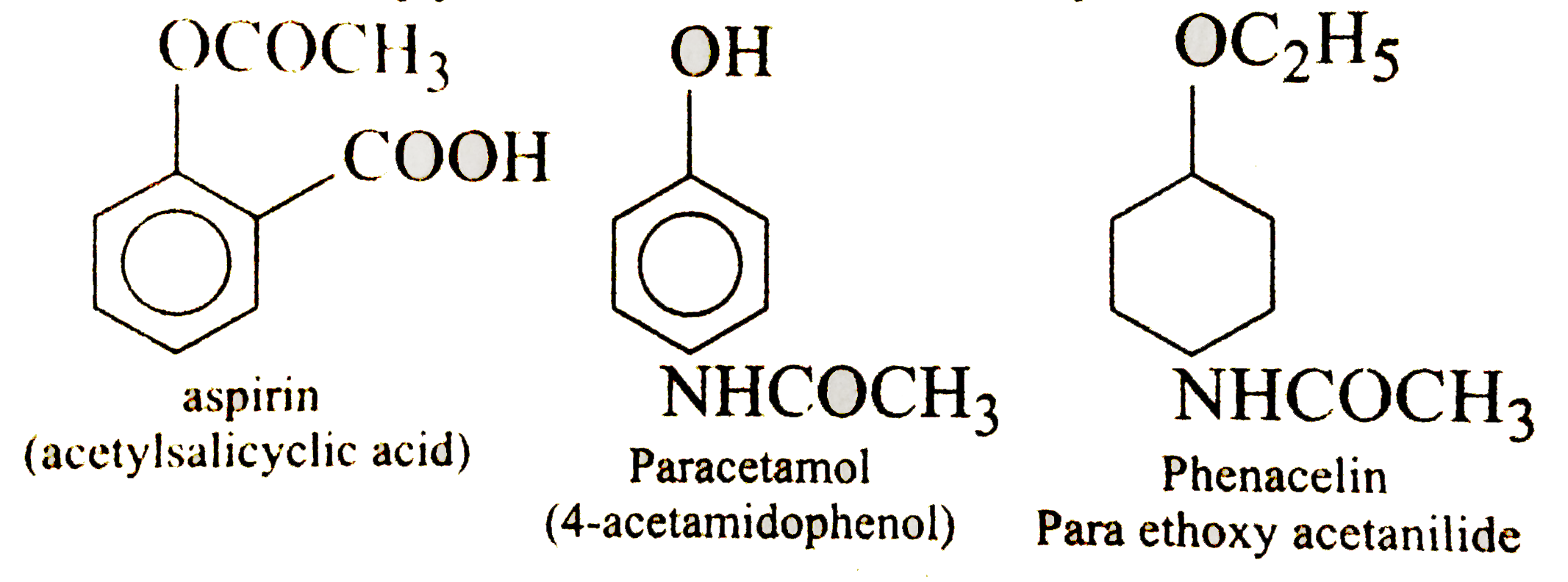
Analgesics are medicines which relieve pain. They are of two types. (i) Narcotics are medicines which relieve pain by producing sleep and unconsciousness. They are morphine, morphine diacetate (heroin) and codeine. They are habit forming (ii) None narcotic analgesics are not habit forming and do not usually induce sleep. They are aspirin, brufen and butazolidine.
Antiseptics are medicines which kill or prevent the growth of micro-organisms. Antiseptics are also used to reduce odours arising out of bacterial decomposition on the surface of the body. They are 2% solution of phenol, dettol (a solution of terpineol and chloro-xylenol) savlon, bithional etc.
Tranquillizers are medicine used to relieve mental tension and an anxiety. They act on the nervous system and induce sleep. They may antidepressants (to elevate mood) such as methedrine and vitalin, sedatives (relieve mental agitation and violence) such as diazopam, seconal, luminal and equanil.
Antibiotics are medicines produced by micro-organisms such as fungi, bacteria and moulds and are used to kill other microorganisms. They are penicillin (Treat sore throat, bronchitis, pneumonia), streptomycin (active aginst tuberclosis, chloramphenicol treat typhoid, acute fever, urinary infection.
Aspirin :View Solution
Knowledge Check
- Question 1 - Select One
Synthetic tranquillisers are mostly barbituric acid derivatives (e.g. veronal, luminal, seconal, amytal and nembutal). Other tranquillisers which are not barbituric acid derivatives are chlordiazepoxide, equanil meprobamate, valium (diazepam), etc. Opium alkaloids such as morphine and codeine are powerful analgesics (reduce pain). Heroin which is morphine diacetate is a widely used narcotic analgesic. Drugs which are used to cure diseases caused by microbes are called antimicrobials. These may be either sulpha drugs such as sulphapyridine, sulphadiazine, sulphaguanidine or they may be antibiotics. Antibiotics such as erythromycin, tetracycline, chloramphenicol which inhibit or arrest the growth of microbes are called bacteriostatic while others which kill the microbes are called bactericidal antibiotics.
Which of the following is/are antibacterials ?APenicillinBSulphapyridineCOfloxacinDAll - Question 2 - Select One
Synthetic tranquillisers are mostly barbituric acid derivatives (e.g. veronal, luminal, seconal, amytal and nembutal). Other tranquillisers which are not barbituric acid derivatives are chlordiazepoxide, equanil meprobamate, valium (diazepam), etc. Opium alkaloids such as morphine and codeine are powerful analgesics (reduce pain). Heroin which is morphine diacetate is a widely used narcotic analgesic. Drugs which are used to cure diseases caused by microbes are called antimicrobials. These may be either sulpha drugs such as sulphapyridine, sulphadiazine, sulphaguanidine or they may be antibiotics. Antibiotics such as erythromycin, tetracycline, chloramphenicol which inhibit or arrest the growth of microbes are called bacteriostatic while others which kill the microbes are called bactericidal antibiotics.
Which of the following tranquillisers is not a derivative of barbituric acid ?AVeronalBEquanilCSeconalDLuminal - Question 3 - Select One
A computer based society becomes a fragile society, easily disrupted, held in the grip of a small technical elite who would have enormous potential power. The controller and operators of the communication channels could exert massive political and social pressure. Technology concentrates power, although in appears to decentralize it. Spreading the computer network into every house, just as television has spread, appears to be bringing the power of computer and information systems to every corner of society. What it, in fact, does is to tighten the grip of a few on many. More people become dependent for their entertainment, their news and information, even for their financial arrangements and household facilities on a small group of people who control and manipulate the system for their own ends. The greater our technological dependence becomes (the more 'freedom' technology gives us), the more fragile does society become. Technological dependence makes a society essentially unstable. It means that communities of people come to rely for their needs (food, work and social interactions) on organizations beyond the horizon of their own community The technological infrastructure of such a society removes functions from local to regional, national or even to international levels. Food is not grown by the local community but)s provided by an agricultural industry backed up by a complex food processing and distribution scheme that itself depends on other industries such as petro-chemical industry which itself is unstable and subject to many other inter-related concerns. A stable society can provide for its own needs on a local scale and would look further only for luxuries. An unstable technological society regards even luxuries as essentials, because to produce them would be economically profitable. The instability of a technologically dependent society is also shown when restrictions are imposed on the rights of its citizens. The high-security computer installation, like the nuclear power station, reduces the citizen's rights. The need to protect society's high technology comes at the expense of restricting what citizens may do or where they be allowed to go. With soft computer technology the loss of rights comes primarily in the form of loss of privacy of information and the difficulty of finding out what information in held by whom, for what purpose, on whom Countries themselves are not immune. Spy satellites look down on neutral as well as on the hostile. We are all gloablly watch, so that whatever is done anywhere is done in public.
Which of the following is true about comprehension?AFor comprehension prior knowledge of the subject is required.BIt is an active process in which the reader works to construct a meaningful message from a textCLearner's decoding skills are not requiredDComprehension requires a learner to have good vocabulary.
The chemicals used to treat diseases and to reduce the suffering from pain are known as drugs or medicines. The chemicals used in chemotherapy are classified according to their action.
For example antipyretics are medicines used to lower the body temperature in high fever. The examples of antipyretics are para ethoxy acetamide and analgin.
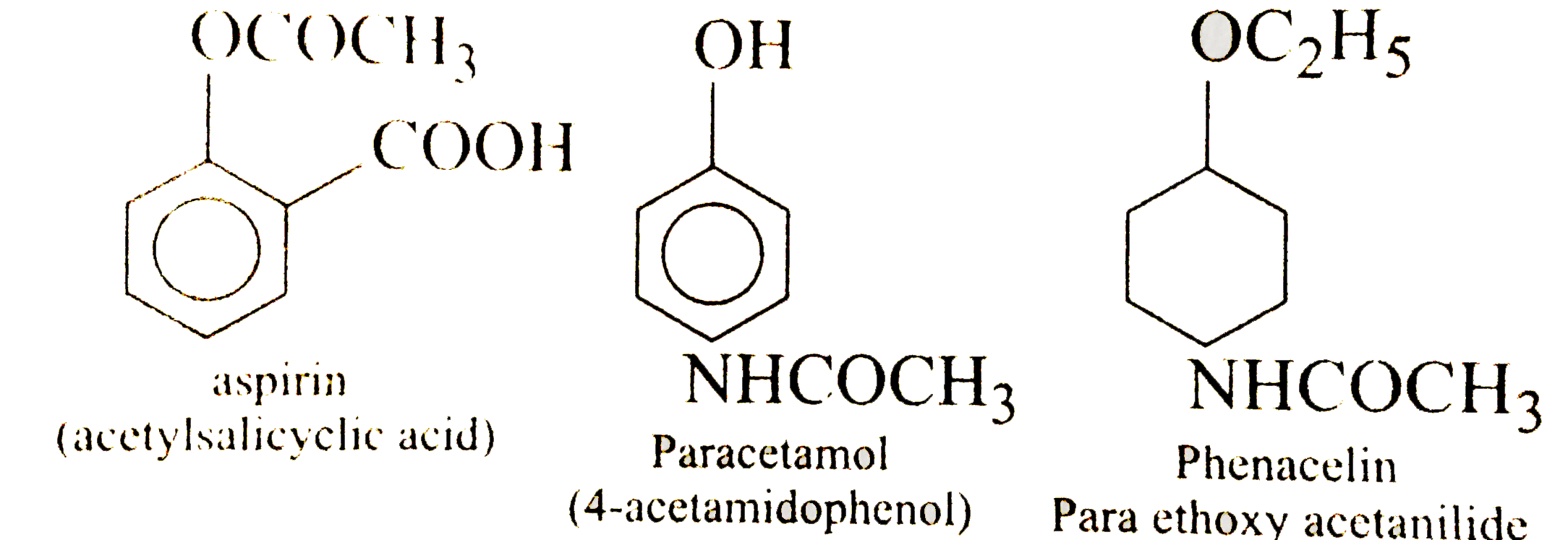
Analgesics are medicines which relieve pain. They are of two types. (i) Narcotics are medicines which relieve pain by producing sleep and unconsciousness. They are morphine, morphine diacetate (heroin) and codeine. They are habit forming (ii) None narcotic analgesics are not habit forming and do not usually induce sleep. They are aspirin, brufen and butazolidine.
Antiseptics are medicines which kill or prevent the growth of micro-organisms. Antiseptics are also used to reduce odours arising out of bacterial decomposition on the surface of the body. They are 2% solution of phenol, dettol (a solution of terpineol and chloro-xylenol) savlon, bithional etc.
Tranquillizers are medicine used to relieve mental tension and an anxiety. They act on the nervous system and induce sleep. They may antidepressants (to elevate mood) such as methedrine and vitalin, sedatives (relieve mental agitation and violence) such as diazopam, seconal, luminal and equanil.
Antibiotics are medicines produced by micro-organisms such as fungi, bacteria and moulds and are used to kill other microorganisms. They are penicillin (Treat sore throat, bronchitis, pneumonia), streptomycin (active aginst tuberclosis, chloramphenicol treat typhoid, acute fever, urinary infection.
The drug mathedrine belongs to the class of :View SolutionThe chemicals used to treat diseases and to reduce the suffering from pain are known as drugs or medicines. The chemicals used in chemotherapy are classified according to their action.
For example antipyretics are medicines used to lower the body temperature in high fever. The examples of antipyretics are para ethoxy acetamide and analgin.
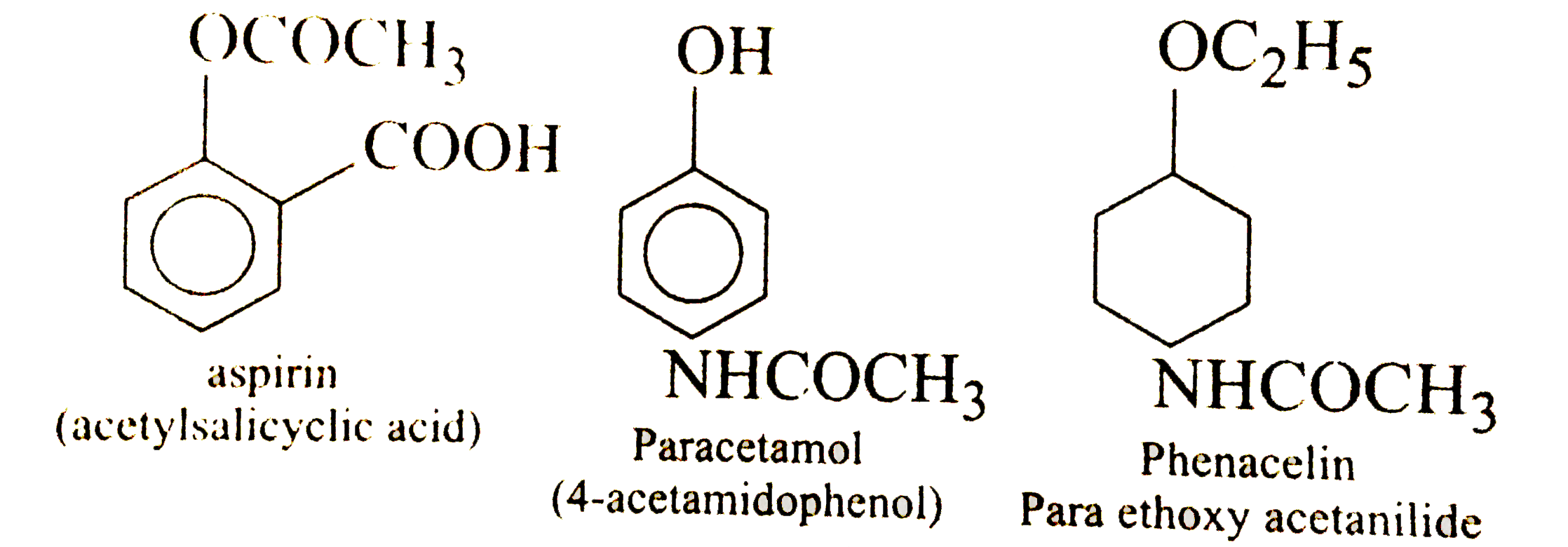
Analgesics are medicines which relieve pain. They are of two types. (i) Narcotics are medicines which relieve pain by producing sleep and unconsciousness. They are morphine, morphine diacetate (heroin) and codeine. They are habit forming (ii) None narcotic analgesics are not habit forming and do not usually induce sleep. They are aspirin, brufen and butazolidine.
Antiseptics are medicines which kill or prevent the growth of micro-organisms. Antiseptics are also used to reduce odours arising out of bacterial decomposition on the surface of the body. They are 2% solution of phenol, dettol (a solution of terpineol and chloro-xylenol) savlon, bithional etc.
Tranquillizers are medicine used to relieve mental tension and an anxiety. They act on the nervous system and induce sleep. They may antidepressants (to elevate mood) such as methedrine and vitalin, sedatives (relieve mental agitation and violence) such as diazopam, seconal, luminal and equanil.
Antibiotics are medicines produced by micro-organisms such as fungi, bacteria and moulds and are used to kill other microorganisms. They are penicillin (Treat sore throat, bronchitis, pneumonia), streptomycin (active aginst tuberclosis, chloramphenicol treat typhoid, acute fever, urinary infection.
Which of the following statements is false ?View SolutionThe chemicals used to treat diseases and to reduce the suffering from pain are known as drugs or medicines. The chemicals used in chemotherapy are classified according to their action.
For example antipyretics are medicines used to lower the body temperature in high fever. The examples of antipyretics are para ethoxy acetamide and analgin.
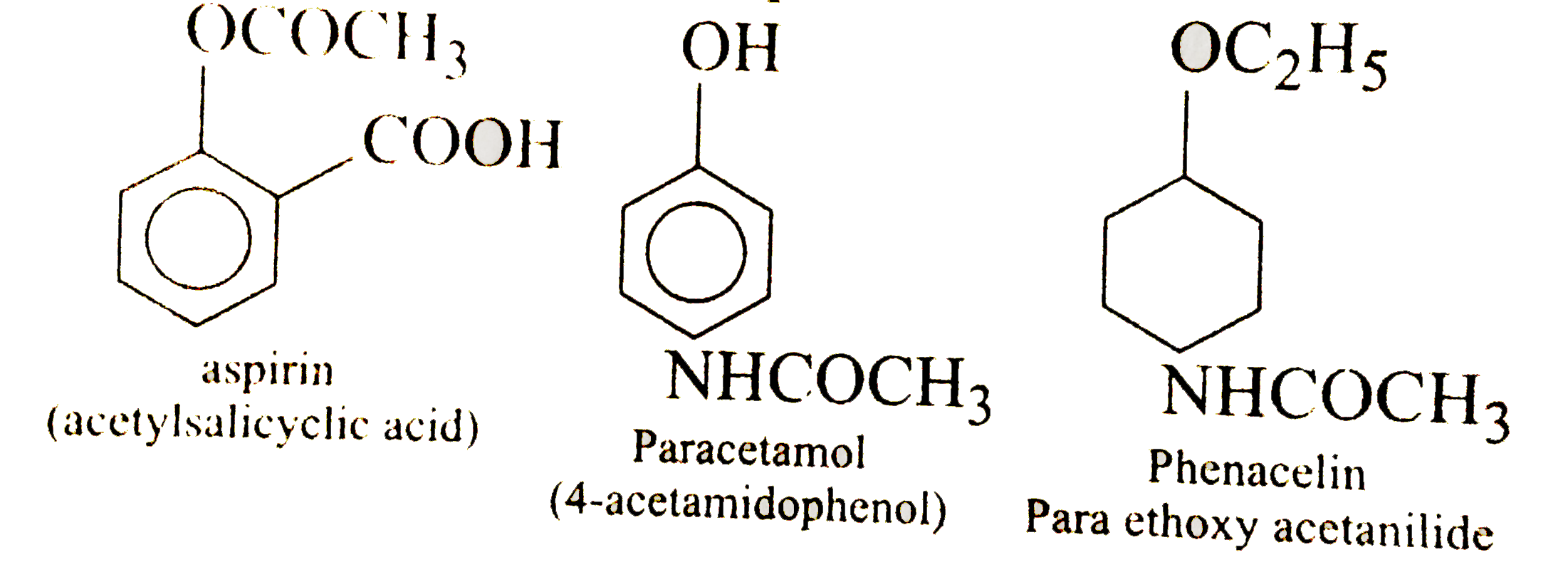
Analgesics are medicines which relieve pain. They are of two types. (i) Narcotics are medicines which relieve pain by producing sleep and unconsciousness. They are morphine, morphine diacetate (heroin) and codeine. They are habit forming (ii) None narcotic analgesics are not habit forming and do not usually induce sleep. They are aspirin, brufen and butazolidine.
Antiseptics are medicines which kill or prevent the growth of micro-organisms. Antiseptics are also used to reduce odours arising out of bacterial decomposition on the surface of the body. They are 2% solution of phenol, dettol (a solution of terpineol and chloro-xylenol) savlon, bithional etc.
Tranquillizers are medicine used to relieve mental tension and an anxiety. They act on the nervous system and induce sleep. They may antidepressants (to elevate mood) such as methedrine and vitalin, sedatives (relieve mental agitation and violence) such as diazopam, seconal, luminal and equanil.
Antibiotics are medicines produced by micro-organisms such as fungi, bacteria and moulds and are used to kill other microorganisms. They are penicillin (Treat sore throat, bronchitis, pneumonia), streptomycin (active aginst tuberclosis, chloramphenicol treat typhoid, acute fever, urinary infection.
Which of the following is antipyretic?View SolutionThe chemicals used to treat diseases and to reduce the suffering from pain are known as drugs or medicines. The chemicals used in chemotherapy are classified according to their action.
For example antipyretics are medicines used to lower the body temperature in high fever. The examples of antipyretics are para ethoxy acetamide and analgin.
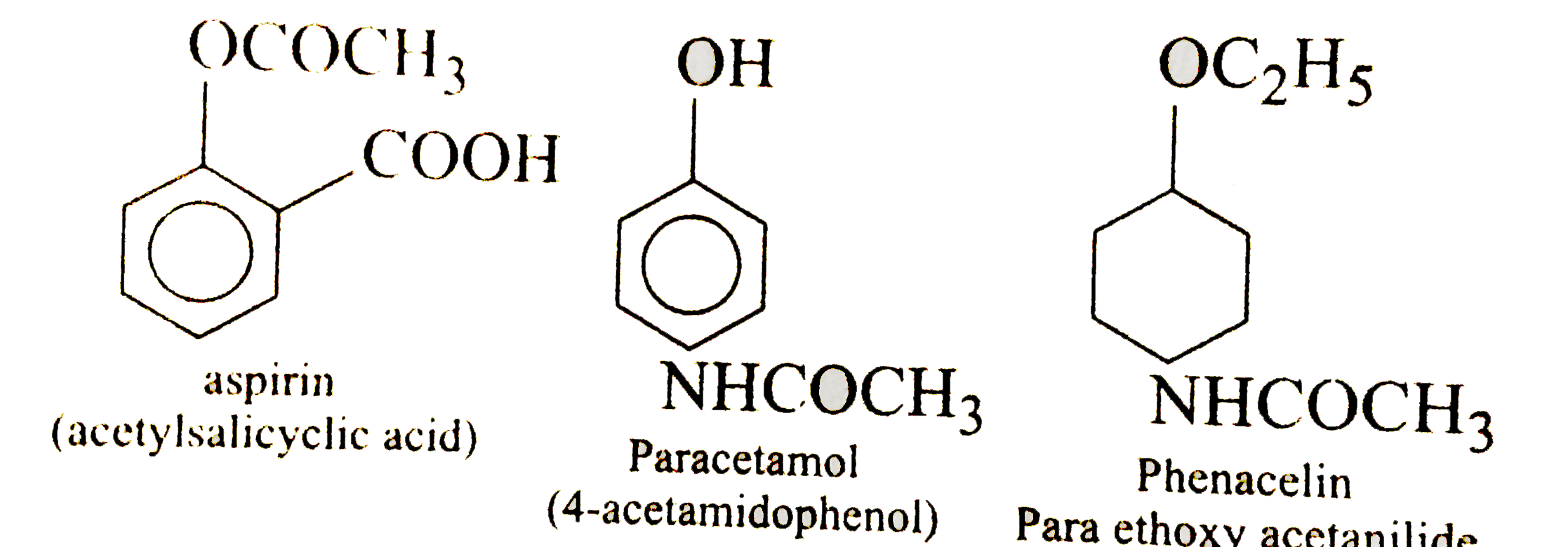
Analgesics are medicines which relieve pain. They are of two types. (i) Narcotics are medicines which relieve pain by producing sleep and unconsciousness. They are morphine, morphine diacetate (heroin) and codeine. They are habit forming (ii) None narcotic analgesics are not habit forming and do not usually induce sleep. They are aspirin, brufen and butazolidine.
Antiseptics are medicines which kill or prevent the growth of micro-organisms. Antiseptics are also used to reduce odours arising out of bacterial decomposition on the surface of the body. They are 2% solution of phenol, dettol (a solution of terpineol and chloro-xylenol) savlon, bithional etc.
Tranquillizers are medicine used to relieve mental tension and an anxiety. They act on the nervous system and induce sleep. They may antidepressants (to elevate mood) such as methedrine and vitalin, sedatives (relieve mental agitation and violence) such as diazopam, seconal, luminal and equanil.
Antibiotics are medicines produced by micro-organisms such as fungi, bacteria and moulds and are used to kill other microorganisms. They are penicillin (Treat sore throat, bronchitis, pneumonia), streptomycin (active aginst tuberclosis, chloramphenicol treat typhoid, acute fever, urinary infection.
Medicine which is antibiotic is :View SolutionThe chemicals used to treat diseases and to reduce the suffering from pain are known as drugs or medicines. The chemicals used in chemotherapy are classified according to their action.
For example antipyretics are medicines used to lower the body temperature in high fever. The examples of antipyretics are para ethoxy acetamide and analgin.
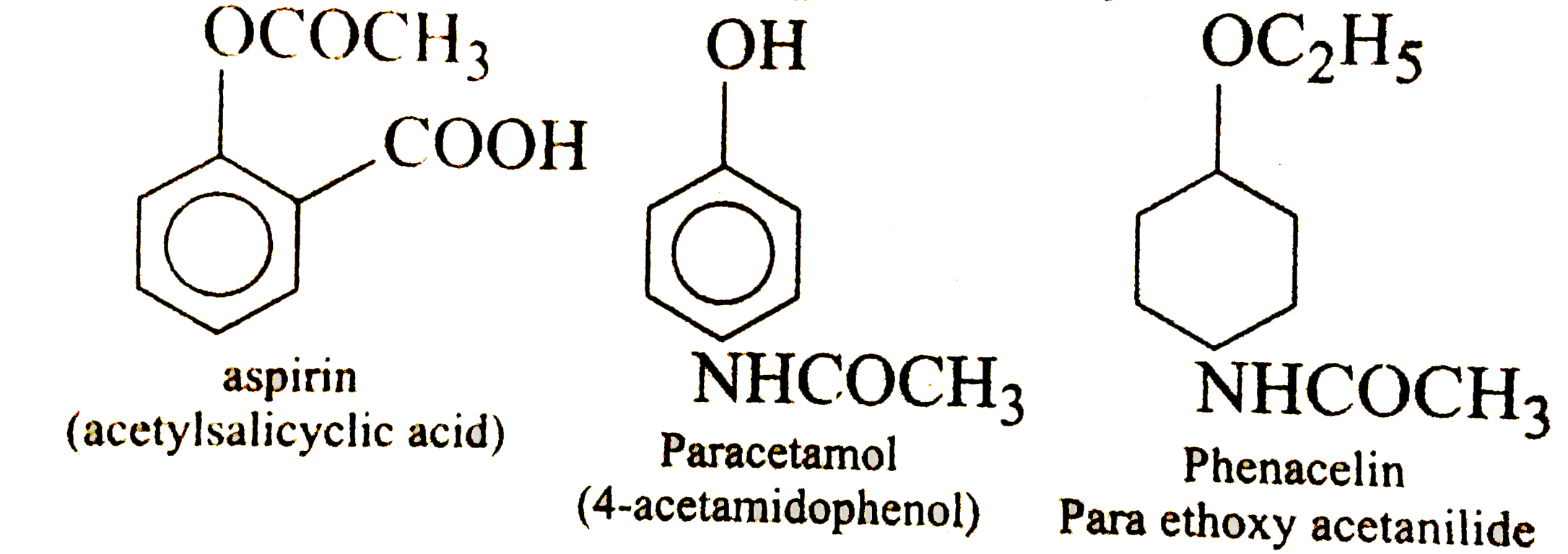
Analgesics are medicines which relieve pain. They are of two types. (i) Narcotics are medicines which relieve pain by producing sleep and unconsciousness. They are morphine, morphine diacetate (heroin) and codeine. They are habit forming (ii) None narcotic analgesics are not habit forming and do not usually induce sleep. They are aspirin, brufen and butazolidine.
Antiseptics are medicines which kill or prevent the growth of micro-organisms. Antiseptics are also used to reduce odours arising out of bacterial decomposition on the surface of the body. They are 2% solution of phenol, dettol (a solution of terpineol and chloro-xylenol) savlon, bithional etc.
Tranquillizers are medicine used to relieve mental tension and an anxiety. They act on the nervous system and induce sleep. They may antidepressants (to elevate mood) such as methedrine and vitalin, sedatives (relieve mental agitation and violence) such as diazopam, seconal, luminal and equanil.
Antibiotics are medicines produced by micro-organisms such as fungi, bacteria and moulds and are used to kill other microorganisms. They are penicillin (Treat sore throat, bronchitis, pneumonia), streptomycin (active aginst tuberclosis, chloramphenicol treat typhoid, acute fever, urinary infection.
Antiseptic action of dettol is due to :View Solution
